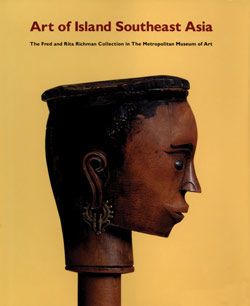Sword handle
This carved figure would have formed the handle of a metal sword, possibly a piso sanalenggam used in ritual activities by the Toba Batak. The kneeling figure leans slightly forward, mirroring the curve of the now-missing blade. Attenuated arms rest on the figure’s thighs, with elongated fingers tucked between the knees and thumbs touching to create a diamond-shaped space in between the hands. A pair of elaborate ear ornaments are carved on either side of the figure’s head, which is topped with a forked headdress decorated with intricately carved foliate patterns. The headdress contains a small cavity to hold pukpuk—a powerful substance made from ritually prepared human and animal remains—that would give the sword added strength and power.
The Toba Batak, one of six groups among the Batak peoples of northern Sumatra, live in the mountainous highlands surrounding Lake Toba (the birthplace of the Batak, according to oral histories and myths). The Batak maintained trade relations with their Malay neighbors living on the coast but otherwise remained relatively isolated until the 18th and 19th centuries when Dutch and British traders, along with German missionaries, established operations in Sumatra. Although nearly all Batak today are Christian or Muslim, they formerly recognized diverse supernatural beings, including deities, ancestors, and malevolent spirits. The primary religious figures in Batak society were male ritual specialists, called datu by the Toba Batak, who acted as intermediaries between the human and spiritual worlds. Much of Toba Batak sacred art centered on the creation and adornment of objects that would be used by the datu for divination, curing ceremonies, malevolent magic, and other rituals. Among the most important were ceremonial staffs, books of ritual knowledge, and a variety of containers used to hold magical substances.
References
Sibeth, Achim. The Batak. London: Thames and Hudson, 1991
This image cannot be enlarged, viewed at full screen, or downloaded.
This artwork is meant to be viewed from right to left. Scroll left to view more.





